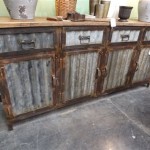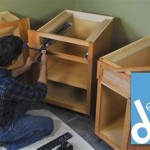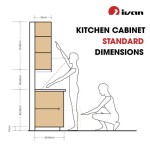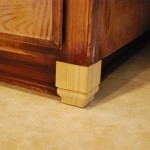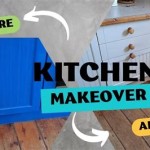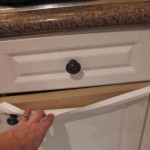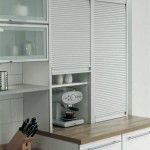Painting Kitchen Cabinets Made Of Particle Board And Wood
Kitchen cabinets are a significant investment in any home. Over time, they can become outdated or simply worn, prompting homeowners to consider replacing them. However, replacing cabinets can be a costly undertaking. A more economical and aesthetically pleasing alternative is painting them. Successfully painting kitchen cabinets made of particle board and wood requires careful preparation, the selection of appropriate materials, and meticulous application techniques. This article provides a comprehensive guide to navigating the process, ensuring a durable and visually appealing outcome.
The first step in painting kitchen cabinets is determining the construction materials. Kitchen cabinets are typically constructed from a combination of materials. Solid wood, particularly for frames and doors, provides durability and a classic aesthetic. Particle board, also known as engineered wood, is a composite material often used for cabinet boxes and panels due to its affordability and stability. Understanding the materials is crucial because each requires slightly different preparation and primer selection.
Particle board, composed of wood chips and resin, presents unique challenges. Its porous surface absorbs paint readily, and its edges can be prone to chipping if not properly sealed. Solid wood, while more durable, may require sanding to ensure proper adhesion of the primer and paint. Identifying which parts of the cabinets are made from which material allows for tailored preparation strategies.
Key Point 1: Preparation is Paramount
Proper preparation is the cornerstone of a successful cabinet painting project. It's a more time-consuming process than the actual painting but is essential for achieving a professional, long-lasting finish. Neglecting preparation can lead to paint peeling, chipping, or uneven coverage, ultimately undermining the entire project.
The first step in preparation is removing all cabinet doors and drawers. Label each door and drawer with a corresponding number or letter on the cabinet frame to ensure proper reinstallation. Remove all hardware, including hinges, knobs, and pulls. Store the hardware in labeled bags to prevent loss or confusion. This disassembly allows for thorough cleaning and sanding of all surfaces.
Next, thoroughly clean all cabinet surfaces with a degreasing cleaner. Kitchen cabinets accumulate grease, grime, and food splatters over time. This residue can prevent paint from adhering properly. A strong degreaser, such as trisodium phosphate (TSP) or a TSP substitute, is recommended. Follow the manufacturer's instructions carefully, and wear appropriate safety gear, including gloves and eye protection. Rinse the surfaces thoroughly with clean water and allow them to dry completely.
Once the cabinets are clean, it's time to address imperfections. Fill any holes, dents, or scratches with wood filler. Apply the filler sparingly, allowing it to dry completely according to the manufacturer's instructions. Sand the filled areas smooth with fine-grit sandpaper (220-grit or higher), blending them seamlessly with the surrounding surface. Sanding is not only for addressing imperfections but also for creating a slightly roughened surface that promotes better primer adhesion. Lightly sand all cabinet surfaces, including doors, drawers, and frames, using fine-grit sandpaper. Remove the sanding dust thoroughly with a tack cloth or a damp cloth.
For particle board, special attention should be paid to the edges. Particle board edges are particularly susceptible to moisture absorption and chipping. Consider using an edge banding product designed for particle board to create a smooth, paintable surface. Apply the edge banding according to the manufacturer's instructions, ensuring a tight bond. Alternatively, use a high-quality wood filler specifically formulated for edges and corners to create a durable and paintable surface.
Key Point 2: Selecting the Right Primer and Paint
The choice of primer and paint is critical for achieving a durable and aesthetically pleasing finish. Using the wrong products can result in poor adhesion, uneven coverage, and a finish that is prone to chipping or peeling. When working with kitchen cabinets composed of particle board and wood, it is essential to select products specifically formulated for these surfaces.
Primer serves several essential functions. It seals the surface, creating a uniform base for the paint; it promotes adhesion, preventing the paint from peeling or chipping; and it blocks stains, preventing them from bleeding through the paint. For kitchen cabinets, a high-quality bonding primer is recommended. Bonding primers are designed to adhere to slick or difficult surfaces, making them ideal for cabinets that may have been previously coated with varnish or other finishes. Look for a primer that is specifically formulated for use on both wood and particle board.
Oil-based primers offer excellent adhesion and stain blocking capabilities but require mineral spirits for cleanup and can have strong odors. Water-based primers are lower in odor, easier to clean up, and offer good adhesion, making them a popular choice for DIY projects. Consider using a tinted primer that is close to the final paint color. This can help to achieve better coverage and reduce the number of coats of paint required.
The selection of paint is equally important. Consider the durability, cleanability, and aesthetic appeal of the paint. For kitchen cabinets, a durable, scrubbable paint is essential. Semi-gloss or gloss finishes are typically recommended because they are easy to clean and resistant to moisture. However, higher gloss levels can highlight imperfections, so it’s important to ensure the surfaces are properly prepared.
Alkyd paints (oil-based) offer excellent durability and a smooth, enamel-like finish. However, they have a strong odor, require mineral spirits for cleanup, and can yellow over time. Latex paints (water-based) are lower in odor, easier to clean up, and offer good durability. Advances in latex paint technology have resulted in products that rival the performance of alkyd paints. Consider using a high-quality acrylic latex paint specifically formulated for cabinets and trim.
Specifically for particle board, using a primer designed to seal porous surfaces is critical. If not properly sealed, the particle board will continue to absorb moisture, causing the paint to peel or bubble over time. Several coats of primer may be needed to effectively seal the particle board, especially on the edges. After priming, lightly sand the primed surface with fine-grit sandpaper to ensure a smooth base for the paint.
Key Point 3: Application Techniques for a Professional Finish
Even with thorough preparation and high-quality materials, the application technique significantly impacts the final result. Applying paint evenly and avoiding common mistakes can lead to a professional-looking finish that enhances the cabinets' durability and appearance.
There are several methods for applying paint to kitchen cabinets, including brushing, rolling, and spraying. Brushing is a traditional method that is suitable for small projects or intricate details. Use a high-quality synthetic brush designed for the type of paint you are using. Apply the paint in thin, even strokes, following the grain of the wood. Avoid overloading the brush, as this can lead to drips and runs. Feather the edges of each stroke to blend seamlessly with the surrounding paint.
Rolling is a faster method for covering large, flat surfaces. Use a high-density foam roller designed for smooth surfaces. Apply the paint in a thin, even coat, overlapping each stroke slightly. Avoid pressing too hard on the roller, as this can create texture. Back-brush the rolled surface with a brush to eliminate any stipple marks and ensure a smooth finish.
Spraying offers the most professional-looking finish but requires specialized equipment and a well-ventilated workspace. An airless sprayer or HVLP (high-volume, low-pressure) sprayer is recommended. Thin the paint according to the manufacturer's instructions to ensure proper atomization. Apply the paint in thin, even coats, overlapping each pass by 50%. Maintain a consistent distance and angle from the surface to avoid runs and drips. Multiple thin coats are better than one thick coat, as they allow the paint to dry evenly and prevent sagging.
Regardless of the application method, applying multiple thin coats of paint is recommended. Allow each coat to dry completely according to the manufacturer's instructions before applying the next coat. Lightly sand between coats with fine-grit sandpaper to remove any imperfections and create a smooth surface for the subsequent coat. This process, known as "de-nibbing," is essential for achieving a flawless finish.
For particle board, apply extra care to the edges during the painting process. The edges of particle board are particularly vulnerable to moisture absorption and chipping. Ensure that the primer and paint are thoroughly applied to the edges, sealing them completely. Several coats may be necessary to achieve adequate coverage and protection. Use a small brush or foam applicator to apply the paint to the edges, paying attention to detail and avoiding runs or drips.
After the final coat of paint has dried completely, allow the cabinets to cure for several days before reinstalling the hardware and doors. Curing allows the paint to fully harden, increasing its durability and resistance to scratches and chips. Once the paint is cured, carefully reassemble the cabinets, reinstalling the hardware and doors in their original locations. Inspect the finish for any imperfections and touch up as needed. A well-prepared and properly painted set of kitchen cabinets can transform the look of a kitchen, providing a cost-effective alternative to replacement.

How To Paint Laminate Cabinets Without Sanding The Palette Muse

How To Paint Fake Wood Kitchen Cabinets Simple Made Pretty 2025

How To Paint Fake Wood Kitchen Cabinets Simple Made Pretty 2025

How To Paint Laminate Cabinets Without Sanding The Palette Muse

How To Paint Your Kitchen Cabinets

How To Paint Fake Wood Kitchen Cabinets Simple Made Pretty 2025

How To Refinish Particle Board Cabinets With Pictures Wikihow

Painting Laminate Kitchen Cabinets Cuckoo4design

Particle Board In Cabinet Making Tips And Tricks One Stop Wood Panel Supplier

How To Paint Particle Board Furniture Diy Dresser Makeover Flipping For Beginners
Related Posts

